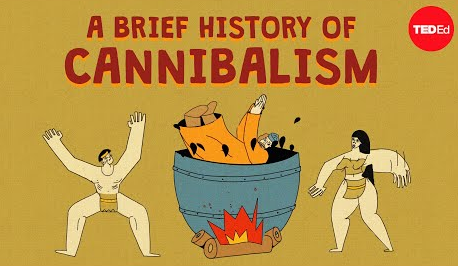15th century Europeans believed they had hit upon a miracle cure:
15世纪的欧洲人相信,他们偶然发现了一种神奇解药,
a remedy for epilepsy, hemorrhage, bruising, nausea, and virtually any other medical ailment.
能治疗癫痫、出血、挫伤、呕吐,几乎包治百病。
This brown powder could be mixed into drinks, made into salves or eaten straight up.
这种棕色粉末可掺进饮料里、做成药膏、或者直接口服。
It was known as mumia and made by grinding up mummified human flesh.
它被称作“mumia”,由人肉干磨碎制成。
The word "cannibal" dates from the time of Christopher Columbus; in fact, Columbus may even have coined it himself.
“食人族”一词起源于哥伦布时代,实际上,这个词可能是哥伦布创造的。
After coming ashore on the island of Guadaloupe,
在登陆瓜达鲁佩岛后,
Columbus' initial reports back to the Queen of Spain described the indigenous people as friendly and peaceful
哥伦布在给西班牙女王的首次报告中,描绘了当地土著人的友善与和平,
though he did mention rumors of a group called the Caribs, who made violent raids and then cooked and ate their prisoners.
但他也提到了加勒比族的传言,据说他们会暴力袭击并煮食俘虏。
In response, Queen Isabella granted permission to capture and enslave anyone who ate human flesh.
作为回应,伊莎贝拉女王颁布了允许抓捕和奴役食人者的命令。
When the island failed to produce the gold Columbus was looking for,
当岛上的黄金被掠夺得所剩无几后,
he began to label anyone who resisted his plundering and kidnapping as a Caribe.
他开始将抵抗者归为加勒比人。
Somewhere along the way, the word "Carib" became "Canibe" and then "Cannibal."
久而久之,“加勒比人”变成了“Canibe”,最后演变为“食人族”。
First used by colonizers to dehumanize indigenous people, it has since been applied to anyone who eats human flesh.
这个词一开始被殖民者用来对原住民去人性化,之后成为对所有食人者的统称。
So the term comes from an account that wasn't based on hard evidence, but cannibalism does have a real and much more complex history.
虽然词语的由来缺乏有力证据,但人类相食确实有着漫长而复杂的历史。
It has taken diverse forms -- sometimes, as with mumia, it doesn't involved recognizable parts of the human body.
食人有多种形式,比如像mumia的粉末,这种形式无法辨别出所用的人体部位。
The reasons for cannibalistic practices have varied, too.
食人的理由也多种多样。
Across cultures and time periods, there's evidence of survival cannibalism,
历史上许多时期都有过为了生存的食人记载,
when people living through a famine, siege or ill-fated expedition had to either eat the bodies of the dead or starve to death themselves.
当遭受饥荒、受到封锁或者远征途中遭遇不幸时,人们只能选择吃死人或是成为死人。

But it's also been quite common for cultures to normalize some form of eating human flesh under ordinary circumstances.
但在很多文化中,食人在日常生活中也不足为奇。
Because of false accounts like Columbus's, it's difficult to say exactly how common cultural cannibalism has been
由于类似哥伦布的错误记载,我们很难透彻了解食人在文化中有多常见,
but there are still some examples of accepted cannibalistic practices from within the cultures practicing them.
但可以知道的是,有些文化接受食人行为。
Take the medicinal cannibalism in Europe during Columbus's time.
比如中世纪的医用食人法。
Starting in the 15th century, the demand for mumia increased.
在15世纪,mumia供不应求。
At first, stolen mummies from Egypt supplied the mumia craze, but soon the demand was too great to be sustained on Egyptian mummies alone,
一开始,商人从埃及偷盗木乃伊,但不久后,木乃伊无法应对需求的激增,
and opportunists stole bodies from European cemeteries to turn into mumia.
投机者便从欧洲的墓园偷盗尸体制成药粉。
Use of mumia continued for hundreds of years.
mumia疗法持续了几百年,
It was listed in the Merck index, a popular medical encyclopedia, into the 20th century.
它被列在著名医药百科全书《默克索引》中,进入了二十世纪。
And ground up mummies were far from the only remedy made from human flesh that was common throughout Europe.
欧洲常见的人肉制品远不止磨碎的木乃伊。
Blood, in either liquid or powdered form, was used to treat epilepsy,
液体和粉状的人血都曾被用来治疗癫痫,
while human liver, gall stones, oil distilled from human brains, and pulverized hearts were popular medical concoctions.
肝脏、胆结石、人脑提炼的油、以及磨碎的心脏都是很受欢迎的药方。
Cannibalistic funerary rites are another form of culturally sanctioned cannibalism.
食人葬礼仪式是另一种被文化认同的食人形式。
Perhaps the best-known example came from the Fore people of New Guinea.
或许最著名的例子是新几内亚的法雷人。
Through the mid-20th century, members of the community would, if possible, make their funerary preferences known in advance,
20世纪中期,很多法雷人会尽可能提前公布自己的葬礼偏好,
sometimes requesting that family members gather to consume the body after death.
有时会请求家庭成员们在自己死后一同吃掉尸体。
Tragically, though these rituals honored the deceased, they also spread a deadly disease known as kuru through the community.
不幸的是,虽然这些仪式表达了对死者的敬意,但也传播了一种致命的疾病:库鲁病。
Between the fictionalized stories, verifiable practices, and big gaps that still exist in our knowledge, there's no one history of cannibalism.
在虚构故事、可证实的做法和我们贫瘠的知识中,食人的历史尚未有统一的说法。
But we do know that people have been eating each other, volunteering themselves to be eaten,
但我们知道,人类同类相食,自愿被吃,
and accusing others of eating people for millennia.
以及指控他人吃人已有数千年之久。


